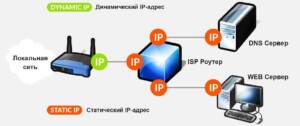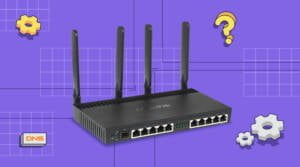- What is a static IP address and what are its advantages?
- What tasks can be solved using a static IP address?
- How to find out your IP address and its type
- Differences between dynamic and static IP address
- How to assign a static IP address on Windows
- Detailed algorithm for setting up a static IP address on Windows
- How to Set Up a Static IP Address on Mac
- Step 1: Open Network Settings
- Step 2: Select your network connection
- Step 3: Set up an IP address
- Step 4: Apply Changes
- How to Set Up a Static IP Address on Linux
- Detailed algorithm for setting up a static IP address on Linux
What is a static IP address and what are its advantages?
A static IP address is a permanent IP address that is assigned to a computer or other network device. Unlike a dynamic IP address, which changes every time you connect to a network, a static IP address remains the same. One of the main advantages of a static IP address is that it is convenient for remote access to a computer or network device. A static IP address can also be useful when setting up certain applications or services that require constant communication with a specific IP address. On the other hand, a static IP address has its own disadvantages. First, it can be more vulnerable to cyber attacks and hacker attacks. Also, a static IP address can be more expensive than a dynamic one, especially if you use it for multiple computers or devices. Overall, a static IP address is a useful tool for those who need reliable communication with a specific device or application. If you want to set up a static IP address on your computer, follow our step-by-step instructions.
What tasks can be solved using a static IP address?
A static IP address is a permanent address for your computer on the Internet. It can be useful in many situations, such as:
1. Remote access to your computer - If you have a static IP address, you can set up remote access to your computer even if you are in a different location. This can be useful if you want to access files on your computer when you are away from it.
2. Website Hosting – If you want to create your own website, then you need a static IP address. This will allow your visitors to access your site all the time and without any problems.
3. Security – A static IP address can be useful for keeping your network secure. You can set up filters to block unwanted users from accessing your network.
4. Gaming – If you play online games, then a static IP address can be useful to ensure a more stable connection.
Overall, a static IP address can be useful in many situations. If you want to set up a static IP address on your computer, then follow our step-by-step instructions.
How to find out your IP address and its type
An IP address is a unique identifier of your device on the Internet. To find out your IP address, open any browser and enter the query 'My IP address' in the search bar. The top search result will show your IP address.
There are two types of IP address: dynamic and static. A dynamic IP address is assigned by your Internet service provider and changes every time you connect to the network. A static IP address is assigned on a permanent basis and does not change with each connection.
It is important to understand that a static IP address can only be assigned by your Internet service provider, so you can only find out your static IP address by contacting your ISP.
Now that you know your IP address and its type, you can move on to setting up a static IP address on your computer.
Differences between dynamic and static IP address
An IP address is a unique identifier for a computer on a network. There are two types of IP addresses: dynamic and static.
A dynamic IP address is automatically assigned to your computer when it connects to the network. It may change every time the computer is reconnected to the network. This type of IP address is convenient for use in home networks, as it does not require additional configuration.
A static IP address is an address that is permanently assigned to a computer. It does not change when you reconnect to the network and requires manual configuration. A static IP address is often used in business networks to ensure a stable connection to other computers and servers.
How to set up a static IP address on your computer: step-by-step instructions
1. Open 'Control Panel' on your computer.
2. Select 'Network and Internet' and go to the 'Network and Sharing Center' section.
3. Click on 'Change adapter settings'.
4. Find your network connection and right-click on it.
5. Select properties.
6. Select protocol version 4 (TCP/IPv4) and click on the 'Properties' button.
7. Select 'Use the following IP address'.
8. Enter the IP address, subnet mask and default gateway.
9. Click on the 'OK' button.
Ready! You have successfully configured a static IP address on your computer. Now you can enjoy a stable connection with other computers and servers on the network.
How to assign a static IP address on Windows
Assigning a static IP address to your computer can allow you to manage your network better and improve the security of your system. If you want to set up a static IP address on a Windows computer, follow these step-by-step instructions:
1. Click 'Start' and select 'Control Panel'.
2. In the 'Network and Internet' section, select 'Network Connections'.
3. Find the desired connection to which you want to assign a static IP address and right-click on its icon.
4. Select 'Properties'.
5. In the list of available components, select 'Internet Protocol Version 4 (TCP/IPv4)' and click the 'Properties' button.
6. Select 'Use the following IP address' and enter the address, subnet mask and default gateway you want to assign.
7. If you want to use specific DNS servers, select 'Use the following DNS servers' and enter their addresses.
8. Click 'OK' to save the changes.
You have now assigned a static IP address on your computer. This process may vary depending on the version of Windows and your network settings. But if you followed this step-by-step instruction, then you should have successfully configured a static IP address on your computer.
Detailed algorithm for setting up a static IP address on Windows
If you want to set up a static IP address on your computer, then follow these simple steps:
1. Open 'Control Panel' on your computer.
2. Click on 'Network and Internet'.
3. Select 'Network Connections'.
4. Find your network connection and right-click on it.
5. Select 'Properties'.
6. Select 'Internet Protocol Version 4 (TCP/IPv4)' and click on 'Properties'.
7. Select 'Use the following IP address'.
8. Enter your static IP address, subnet mask and default gateway.
9. Enter the addresses of the DNS servers you want to use.
10. Click 'Ok' and close all windows.
You can now use your new static IP address on your computer. This can be useful if you want to configure access by IP address or if you work with certain network applications. Don't forget to save the settings and restart your computer for the changes to take effect.
How to Set Up a Static IP Address on Mac
Setting up a static IP address on Mac may seem like a daunting task for beginners, but it is actually a fairly simple procedure. A static IP address allows your computer to have a permanent address on your local network, which is useful for certain applications and devices.
Step 1: Open 'System Preferences' on Mac.
Step 2: Click on 'Network'.
Step 3: Select the connection type you are using (Wi-Fi or Ethernet).
Step 4: Click on 'Advanced' to open advanced network options.
Step 5: Under 'TCP/IP', select 'Static IP'.
Step 6: Enter the IP address, subnet mask and default gateway. Your network administrator can provide this information.
Step 7: Click on 'Apply' to save the changes.
Your Mac is now configured to use a static IP address on your local network. If you are unsure what values to use for the IP address, subnet mask, and default gateway, contact your network administrator or Internet service provider.
Setting up a static IP address on a Mac is a process that may seem complicated for beginners. However, with this step-by-step guide, you can easily set up a static IP address on your computer.
Step 1: Open Network Settings
Go to 'System Preferences' and select 'Network'. Here you will see all available network connections, including Wi-Fi, Ethernet, etc.
d.
Step 2: Select your network connection
Select the network connection for which you want to configure a static IP address. Click on the 'Advanced' button, which is located to the right of the list of connections.
Step 3: Set up an IP address
In the window that opens, click on the 'TCP/IP' tab. Here you will see the current connection type - DHCP, which automatically assigns an IP address to your computer.
Select 'Static IP Address' and enter the desired IP Address, Subnet Mask and Default Gateway values.
Step 4: Apply Changes
After entering all the values, click on the 'Apply' button to save the changes. Your computer is now using a static IP address.
By following these simple instructions, you can easily set up a static IP address on your Mac computer. This can be useful if you need to have a permanent IP address for your network or if you work with certain applications that require a static IP address.
How to Set Up a Static IP Address on Linux
If you want to set up a static IP address on Linux, then it may seem like a complicated process. But in reality it is not as difficult as it might seem. First, you need to know what IP address you want to configure. You will also need to know the subnet mask and default gateway.
1. Open a terminal and run the command:
sudo nano /etc/network/interfaces
2. In this file you will see a line starting with 'iface eth0 inet dhcp'. Replace this line with:
iface eth0 inet static
address [IP address]
netmask [subnet mask]
gateway [default gateway]
3. Replace [IP Address], [Subnet Mask], and [Default Gateway] with the appropriate values.
4. Press Ctrl+X and then Y to save your changes.
5. Now run the command:
sudo /etc/init.
d/networking restart
6. Check that your IP address is configured correctly, run the command:
ifconfig
If you did everything correctly, you should see your new static IP address.
Now you know how to set up a static IP address on Linux. This can be useful if you want to configure your computer to work on a local network or to access the Internet. Either way, it's a simple process that can be completed in a few minutes.
Detailed algorithm for setting up a static IP address on Linux
A static IP address is a permanent address that is assigned to a device and does not change during operation. If you want to set up a static IP address on a Linux computer, follow this step-by-step guide:
1. Open a terminal and enter the 'ifconfig' command to obtain information about network interfaces.
2. Select the interface you want to configure and enter the command 'sudo nano /etc/network/interfaces' to open the interface configuration file.
3. Add the following lines to the interface configuration file, replacing the IP address, gateway and subnet mask with your values:
auto eth0
iface eth0 inet static
address 192.
168.
0.
2
gateway 192.
168.
0.
1
netmask 255.
255.
255.
0
4. Save your changes by pressing Ctrl+X, then Y, then Enter.
5. Reboot the network interface by entering the command 'sudo ifdown eth0' and then 'sudo ifup eth0'.
6. Verify that the setup was successful by entering the 'ifconfig' command and verifying that the IP address you specified in the interface configuration file is displayed.
You have now configured a static IP address on your Linux machine. This can be useful if you want your computer to always use a specific IP address on your network. When setting a static IP address, there may be some errors that may cause you to not connect to the network properly. One of the main mistakes is the incorrect configuration of the IP address, subnet mask and default gateway. In this case, the computer will not be able to connect to the network and access the Internet.
Another common mistake is using busy IP addresses. This causes an IP address conflict that causes computers to be unable to connect to the network and access the Internet. To avoid this error, you need to check the availability of the IP address before assigning it.
Errors may also occur when setting up the DNS server. If the DNS server is not configured correctly, the computer will not be able to access the Internet. To resolve this error, you must configure your DNS server correctly.
If you encounter these or other errors when setting up a static IP address, don't panic. In most cases, errors can be corrected by following simple instructions. It is important to set the IP address, subnet mask, default gateway, and DNS server correctly so that your computer can connect to the network and access the Internet. To set up a static IP address on your computer, you need to follow certain steps. However, not all users can easily cope with this task. In this article, we will tell you about some of the problems that can arise when setting up a static IP address and give you some tips on how to solve them.
Problem 1: Incorrect IP address. One of the most common problems when setting up a static IP address is entering the wrong IP address. This can happen if you enter the address manually and make typos.
Solution: Check if you entered the IP address correctly. If you are not sure which address to enter, contact your Internet service provider.
Issue 2: The default gateway is incorrect. If you have set the default gateway incorrectly, you will not be able to connect to the Internet.
Solution: Check if you have specified the default gateway correctly. This is usually the address of your router. If you are unsure which address to enter, contact your Internet service provider.
Problem 3: Corrupt settings file. If your settings file is damaged, your computer will not be able to configure a static IP address correctly.
Solution: Try deleting the settings file and creating a new one. If this doesn't help, contact support.
By following these simple tips, you can easily solve problems with setting up a static IP address and configure it correctly on your computer.
Read further:






